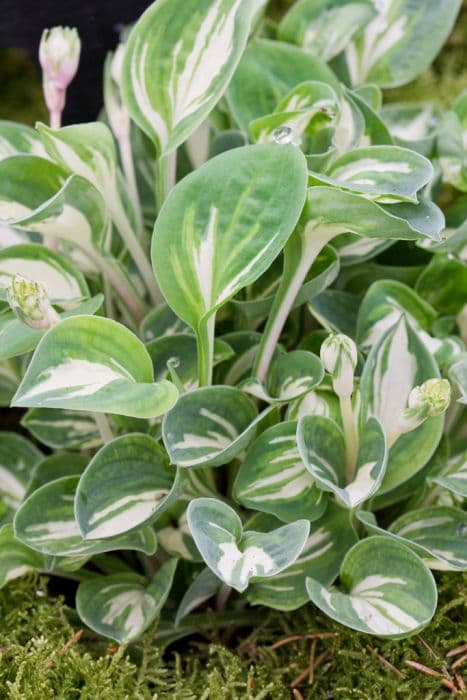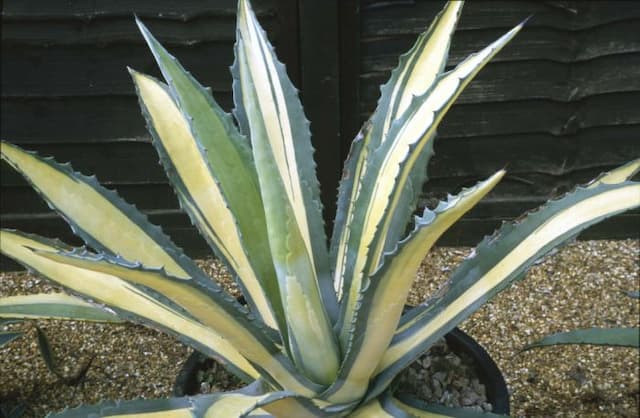Plantain Lily Hosta 'Pandora's Box' (v)

ABOUT
Hosta 'Pandora's Box' displays a charming appearance, characterized by small, heart-shaped leaves. The foliage is particularly eye-catching due to its variegation; the leaves exhibit creamy white centers surrounded by a contrasting green margin. This variegation pattern gives the plant a vibrant, dappled look, creating a visual highlight in shaded garden areas or potted arrangements. During the growing season, it can produce delicate flowers that rise above the foliage on slim, graceful stalks. These blossoms are typically pale lavender to purple and bell-shaped, adding an additional layer of ornamental interest to the already attractive foliage display. Hosta 'Pandora's Box' is a showy, variegated perennial that adds texture and color contrast to its surroundings, without taking up significant space with its refined, compact growth habit.
About this plant
 Names
NamesFamily
Asparagaceae
Synonyms
Plantain Lily, Funkia
Common names
Hosta 'Pandora's Box'
 Characteristics
CharacteristicsLife cycle
Perennials
Foliage type
Deciduous
Color of leaves
Variegated
Flower color
Lavender
Height
1 foot (30 cm)
Spread
1 foot (30 cm)
Plant type
Herb
Hardiness zones
3
Native area
Asia
Benefits
 General Benefits
General Benefits- Ornamental Value: Hosta 'Pandora's Box' is highly valued for its attractive foliage, which adds visual interest to garden spaces.
- Shade Tolerance: This hosta thrives in shaded areas where many plants cannot, making it an excellent choice for shadowy garden spots.
- Versatility: It can be used in a variety of garden designs, including borders, container gardens, and as ground cover.
- Low Maintenance: Hostas typically require little care once established, making them ideal for gardeners who prefer low-maintenance landscaping.
- Texture Contribution: The leaves of Hosta 'Pandora's Box' contribute rich texture to the garden with its variegated patterns.
- Drought Tolerance: Once established, it is relatively drought-tolerant, making it suitable for gardens in drier climates.
- Long-Lived Perennial: Hostas are perennials that can live for many years, making them a lasting addition to gardens.
- Attracts Wildlife: The flowers of the Hosta 'Pandora's Box' can attract bees, butterflies, and other pollinators to the garden.
- Seasonal Interest: Hostas generally have a long growing season, providing interest from spring through fall.
- Easy to Divide: Hosta 'Pandora's Box' can be easily divided to create new plants, allowing gardeners to expand their plantings or share with others.
 Medical Properties
Medical PropertiesThis plant is not used for medical purposes.
 Air-purifying Qualities
Air-purifying QualitiesThis plant is not specifically known for air purifying qualities.
 Other Uses
Other Uses- Fairy Garden Component: Hosta 'Pandora's Box' can be used in fairy gardens due to its miniature size, adding a touch of whimsy and enchantment to the miniature landscape.
- Photography Backdrop: The variegated leaves provide an interesting texture and contrast, making it a beautiful backdrop for photographing other small plants or garden creatures.
- Container Garden Accent: Its small size makes it ideal for adding visual interest to mixed container gardens, especially in shady balcony gardens.
- Border Plant for Shade: They can be planted as a border for garden paths or walkways where taller plants would obscure the view.
- Textural Contrast in Shady Areas: The leaves can be used to provide textural contrast in shady areas of the garden, among other shade-loving plants with different foliage types.
- Pressing and Artwork: The leaves can be carefully pressed and used to create botanical prints or incorporated into mixed media artwork.
- Wedding Decor: Small divisions can be potted and used as eco-friendly wedding favors or as part of table centerpieces in a garden-themed wedding.
- Pond Landscaping: Although not an aquatic plant, it can be used around the edges of ponds or water features to provide lush greenery.
- Education: Hosta 'Pandora's Box' can be used as a living example when teaching about variegation, shade gardening, or plant biology.
- Culinary Garnish: While not a traditional edible, the leaves, if thoroughly cleaned, could potentially be used as an ornamental garnish for plating, in particular for garden-themed culinary events.
Interesting Facts
 Feng Shui
Feng ShuiThe Hosta is not used in Feng Shui practice.
 Zodiac Sign Compitability
Zodiac Sign CompitabilityThe Hosta is not used in astrology practice.
 Plant Symbolism
Plant Symbolism- Mystery: The name 'Pandora's Box' refers to the Greek myth of Pandora, who was given a box and told not to open it. She eventually gave in to her curiosity, releasing all the evils of the world into it, leaving only hope inside. This plant can symbolize the unknown and the mysteries that may be hidden beneath the surface.
- Hope: Following the myth of Pandora, after all the other things escaped from the box, hope remained. Hence, Hosta 'Pandora's Box' can represent the idea that no matter what challenges are faced, there is always hope remaining.
- Resilience: Hostas in general are known for their hardiness and ability to thrive in shady conditions where other plants may struggle. This particular variety, with its distinctive variegation, suggests the theme of resilience and adaptability.
- Beauty in the Shade: This plant thrives in shaded areas, symbolizing beauty that does not require the spotlight to flourish. It represents the idea that there is beauty to be found even in the less obvious, hidden places.
- Contrast: With its variegated leaves, often featuring stark contrasts between green and white, the Hosta 'Pandora's Box' can symbolize the beauty of diversity and the harmonious blending of differences.
 Water
WaterFor the Miniature Hosta, water thoroughly when the top inch of soil feels dry to the touch. Generally, this means watering approximately once a week, but frequency can vary depending on climate and weather conditions. Ensure consistent moisture, especially during the first growing season. Apply about one gallon of water per plant each time you water, ensuring it reaches the root zone. During hot, dry periods, additional watering may be necessary to keep the soil moist, but always avoid overwatering which can lead to root rot.
 Light
LightMiniature Hosta thrives in partial to full shade conditions. The ideal spot for this plant is one where it can receive morning sunlight but is protected from the intense afternoon sun. A location under the canopy of trees or on the north side of a building where it can get filtered light throughout the day is perfect for the Miniature Hosta.
 Temperature
TemperatureMiniature Hosta performs best in temperatures that range from 50 to 75 degrees Fahrenheit, though it can tolerate temperatures down to 30 degrees and up to 90 degrees Fahrenheit. Avoid exposing the Miniature Hosta to extreme temperatures as this can damage the plant. The ideal range of temperatures facilitates healthy growth and maintains foliage quality.
 Pruning
PruningPruning Miniature Hosta is mainly for aesthetic purposes and to remove any dead or damaged leaves. Trim off spent foliage in early spring before new growth starts or in late fall after the leaves have died back. Pruning can occur once a year, and the best time is when the plant is dormant to minimize stress on the Hosta.
 Cleaning
CleaningAs needed
 Soil
SoilHosta 'Pandora's Box', often known as Miniature Hosta, thrives best in a soil mix that is rich, moist, and well-draining. A good mixture might be equal parts of loam, peat moss, and perlite or pine bark to foster aeration and moisture retention. This Miniature Hosta prefers slightly acidic to neutral soil with a pH range of 6.5 to 7.5.
 Repotting
RepottingMiniature Hosta typically requires repotting every 2-3 years to ensure the soil remains nutritious and to accommodate root growth. However, as a smaller cultivar, 'Pandora's Box' may not need to be repotted as frequently if it is not outgrowing its container.
 Humidity & Misting
Humidity & MistingMiniature Hosta prefers moderate to high humidity levels, ideally between 50% and 70%, to maintain healthy growth and appearance.
 Suitable locations
Suitable locationsIndoor
Place Miniature Hosta in bright, indirect light and keep soil moist.
Outdoor
Plant Miniature Hosta in shade to partial sun, in moist soil.
Hardiness zone
3-9 USDA
 Life cycle
Life cycleHosta 'Pandora's Box', commonly known as Hosta or Plantain Lily, begins its life cycle with seed germination, which is relatively uncommon for variegated cultivars as they are usually propagated vegetatively. After germination or division, the plant enters a juvenile phase where it develops a small clump of leaves and begins to establish a root system. As it matures, the Hosta enters a vegetative stage characterized by rapid leaf production and expansion, with its distinctive variegated foliage that features creamy centers bordered by green margins. The plant reaches its reproductive phase in early to midsummer, sending up slender stalks that bear bell-shaped, lavender or white flowers, although this miniaturized variety may not flower as prolifically as larger hostas. After flowering, if pollinated, the plant may produce seed pods, but cultivars like 'Pandora's Box' are often sterile or do not come true from seed. The life cycle concludes with the plant entering a period of dormancy during the winter months, where the foliage dies back, and the plant rests until the following spring when the cycle begins anew.
 Propogation
PropogationPropogation time
Spring-Early Summer
Hosta 'Pandora's Box', often referred to simply as Hosta, is best propagated by division, which is the most popular method for this plant. The ideal time for dividing Hostas is in the early spring or late summer to early fall. To propagate by division, carefully dig up the entire plant, making sure to keep a good amount of soil around the roots. Using a sharp knife or spade, split the plant into smaller sections, each with at least two or three shoots and a corresponding portion of the root system. Replant the divisions immediately at the same soil depth they were originally, and water them well. This will allow the new plants to establish a strong root system before the growing season or over the winter. Dividing not only helps to propagate Hostas, but also to rejuvenate older clumps that may have become too large or dense.

![Beschorneria [Flamingo Glow]](/_next/image?url=https%3A%2F%2Fplants-admin.emdemapps.com%2Fimages%2Fplants%2F%2Fimages%2F604b59df2e78d.png&w=640&q=75)






